|
Canberra PR.9
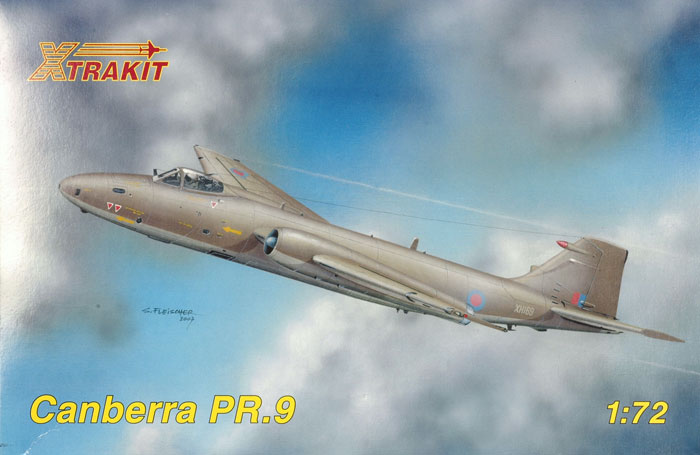
Xtrakit, 1/72 scale
S u m m a r y
|
|
Catalogue Number: |
Xtrakit 72004 -
Canberra PR.9 |
|
Scale: |
1/72 |
| Contents and
Media: |
66
parts in grey plastic; one resin part; 7 clear plastic parts; markings for
two aircraft. |
| Price: |
From
GBP£14.46 available online from Hannants website |
| Review Type: |
FirstLook |
| Advantages: |
Long awaited subject,
crisply engraved panel lines, good level of interior detail;
excellent quality clear parts including clear vertical
camera panel; high quality decals. |
| |
|
| Disadvantages: |
One big ejector pin in
each main wheel well; one-piece canopy (cutting required to
display canopy open). |
|
Recommendation: |
Highly Recommended |
Reviewed by Brett Green
The English Electric Canberra was a
groundbreaking aircraft when it entered service in the early 1950s.
The Canberra set and
held many altitude, distance and speed records in its early years.
In addition to widespread and long service with the Royal Air Force,
the English Electric Canberra was exported to many countries
including Australia, New Zealand, Sweden, France, West Germany,
India, Pakistan, Rhodesia, Ethiopia, Argentina, Chile, Ecuador, Peru
and Venezuela.
The PR.9 was the photo
reconnaissance version of the Canberra.
The Canberra's service record was remarkable in its longevity,
spanning from the Suez crisis to Vietnam right through to Operation
Telic in the Persian Gulf. The Canberra finally left RAF service
when the the PR.9 was retired in 2006.
This is not the first Canberra PR.9 that we have seen in 1/72 scale.
Matchbox released an early version of this variant three decades
ago. That old kit had raised panel lines and fairly basic detail
typical of the era.
Xtrakit has now
released an all-new Canberra PR.9, representing the final version of
this faithful reconnaissance stalwart. This model has nothing in
common with the old Matchbox kit.
Xtrakit's 1/72 scale
new Canberra PR.9 comprises 66 parts in grey plastic, two in grey
resin, seven parts in clear and markings for two aircraft.
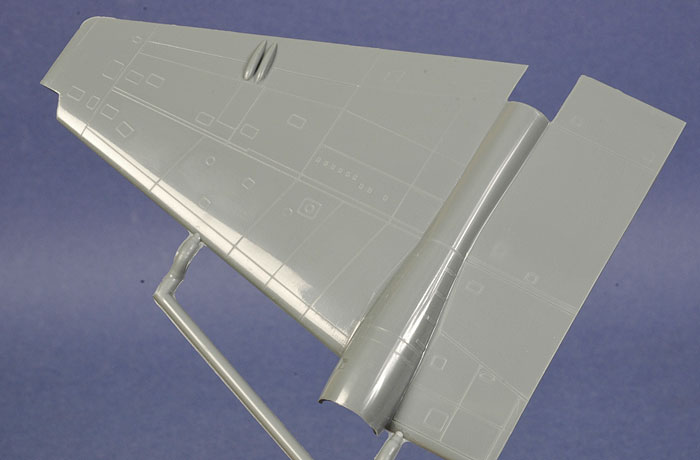
Click the thumbnails below to view larger images:
[../../../photogallery/photo00024641/real.htm]
The plastic parts are
manufactured to a very high standard. The grey styrene is cleanly
moulded, glossy and well detailed with fine, crisp recessed panel
lines and selected raised detail (e.g. vortex generators) as
appropriate. The only imperfection on my sample is one large ejector
pin in each main wheel well.
There are some raised
ejector pins on the inner surfaces of some parts. These will not be
visible on the finished model, but those on the mating surfaces of
the wings and tailplanes will need to be sliced off so that they do
not interfere with fit. There is a little flash (thin excess
plastic) that needs to be removed from some parts.
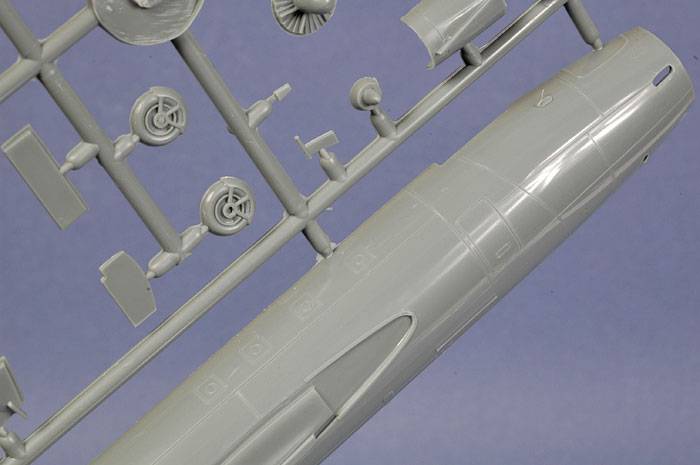
Parts breakdown is
quite conventional. Wings are supplied as full-span top and bottom
halves. The wheel wells are separate parts that may be glued to the
fuselage before the wings are fitted. If the wheel wells are left to
dry on the fuselage, they should act as large and effective wing
spars. I would recommend adding a short length of metal rod to
reinforce the butt-join for the large horizontal tailplanes though.
The model will require
extra weight up front to help the nose wheel stay on the ground, but
there is plenty of space in the nose to allow this.
The nose is supplied as
two separate halves (parts 58 and 59). The instructions advise that
these should be glued together before adding the nose to the
assembled fuselage, but I will be gluing each nose half to each main
fuselage half before assembling the fuselage. This should help
minimize any steps or gaps at the vertical join between the nose and
the fuselage.
Cockpit detail is very
good. The instrument panels and side consoles are moulded in
injected plastic with raised and recessed details. These details
should jump out with a careful paint job. I was pleased to see two
resin seats included in this release, as the pilot's seat is likely
to be the only feature visible in the Canberra's dark cockpit with
its narrow opening.
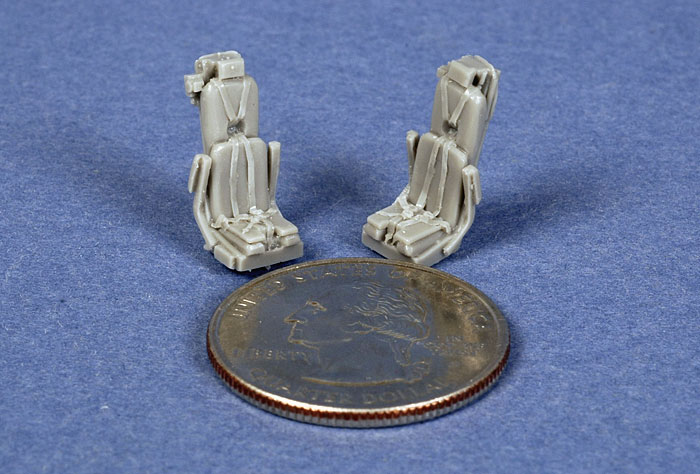
Undercarriage detail is
good too. I particularly like the nose wheel with the mud guard
moulded to the tyre.
Engine fan and exhaust
detail is also depicted.
Clear parts are very
thin and free from distortion. They look a little cloudy on the
sprue but they will shine after a bath in Future floor polish. The
canopy is provided as a single part, so if you want to display the
cockpit you will have to spend a few minutes carefully cutting the
part open with a razor saw.
The inclusion of the
ventral camera ports on a clear part is a nice touch. Small windows
and wing tip navigation lights are included too.
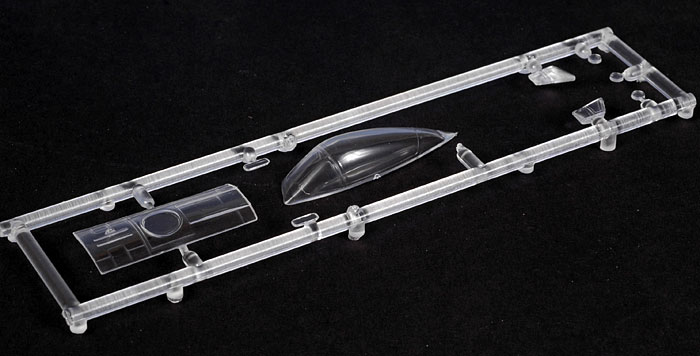
Markings are supplied
for two aircraft:
Both aircraft were based with 39 (1 PRU)
Sqn RAF, Azraq Air Base in Jordan during Operation Telic in 2003,
and are finished in the final scheme of RAF Hemp and Light Aircraft
Grey. The "split" wing roundels on XH169 are particularly
interesting.
Comprehensive low visibility stencil
markings are included.
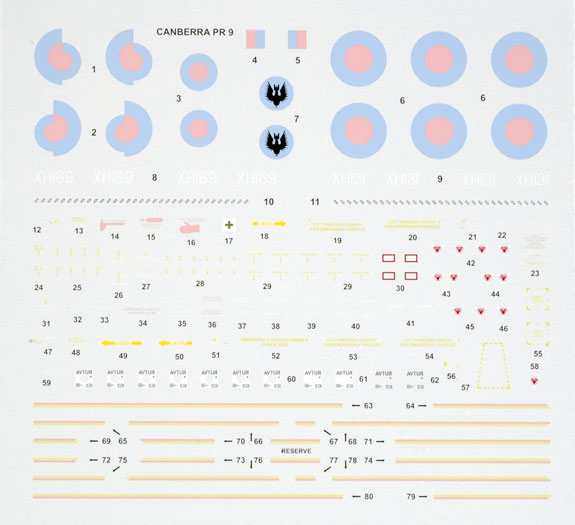
Decals are thin and
nicely in register.
Xtrakit's late version Canberra PR.9 fills an
important gap in the 1/72 scale model lineup. It is a very nice kit
- well detailed, appears to be accurate and should be quite easy to
build too, thanks to sensible parts breakdown and the minimal use of
multi-media parts.
Being a limited run kit means that this Canberra has
no locating pins, so extra time will be required to test fit and
align parts before committing to glue. Make sure you clean up all
the parts of any flash before assembly too.
If you make this small extra effort though,
Xrarkit's 1/72 scale Canberra PR.9 should not be too much more of a
challenge than most mainstream kits.
Highly Recommended.
Thanks to
Hannants for the sample
Xtrakits, Xtraparts
and Xtradecals are all available
online from Hannants' website
Images Copyright © 2007 by Hannants
This Page Created on 19 December, 2007
Last updated
27 December, 2007
Back to
HyperScale Main Page |
Home
| What's New |
Features |
Gallery |
Reviews |
Reference |
Forum |